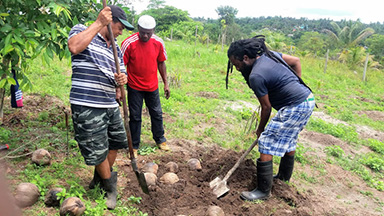Local farmers are expected to have increased access to various varieties of coconut seedlings shortly after several were selected to manage demonstration nurseries that are likely to evolve into commercial entities.
According to the National Agricultural Research and Extension Institute (NAREI), through a multi-agency collaboration, several farmers attached to the Stakeholder Platform, operating in Regions Two, Four, Five and 10 were selected to manage the nurseries. The agencies involved NAREI, the Caribbean Agricultural Research and Development Institute (CARDI), and the International Trade Centre (ITC). The agencies, with financing from the European Union and African, Caribbean and Pacific Secretariat, have taken up the mantle of resuscitating Guyana’s coconut industry.
Chief Executive Officer of NAREI Dr Oudho Homenauth met on Thursday with CARDI’s Country Representative Dr Cyril Roberts and International Consultant of ITC Ben Morrison to discuss activities involved in building a coconut germplasm in Guyana.
A NAREI statement said that within recent weeks, representatives of the agencies and farmers have been collecting nuts from healthy mother palms, which they have also been marking. The nuts were placed in nurseries built by lead farmers, with assistance from secondary farmers. It is expected that the secondary farmers will receive a percentage of good seedlings from the lead farmers.
The goal of this aspect of the project is to produce 5,000 coconut seedlings. The farmers will be able to continuously supply the demands for planting materials locally. Of the 10 demonstration nurseries that will be established, four are now operational. Two of the four nurseries are located in Mahaica, one at Linden and the other at Buxton. Currently, each nursery has about 400 seedlings.
The statement said that once managed properly, these nurseries will transform into commercial entities. Following a cost analysis, a price per seedling would be derived. However, the intention is have farmers pay a fair, stable price per seedling. Many farmers find the present market price per seedling burdensome, the statement said.
“The establishment of these nurseries allows the beneficiaries to apply theoretical knowledge gained from several training exercises, such as integrated pest management, coconut husbandry, business, and nursery management to the practical. Further, it presents the opportunity for farmers to improve their livelihoods,” it added.






